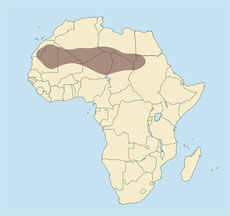Addax - Africa | Online Record Book Preview
This is a preview of the Addax - Africa species only.
Once you subscribe you will be able to view all the entry details for hundreds of different species, including full score sheets and photos.
This species has several classifications, to view each one you can click on the links below to jump down to that section:
Addax - Africa |
 |
Addax nasomaculatus
Adax (Sp), Addax, Mendesantilope (G), Addax (F). According to Plinius, the elder, "addax" is the name of a wild animal in Africa with crooked horns.
DESCRIPTION (male) Shoulder height 37-45 inches (95-115 cm). Weight 220-295 pounds (100-135 kg). Females are smaller.
The addax is a medium-sized antelope of stocky build, with long, spiral horns. Overall color is a sandy gray with white underparts and legs. There is a brown patch on the forehead and a white patch across the muzzle in front of the eyes. The tail is fairly long with a black tuft. The hoofs are much enlarged for walking on desert sands. Both sexes grow horns, which are prominently ringed, spirally twisted (up to three turns), and divergent. Females are somewhat smaller than males and have thinner, shorter horns, but are otherwise similar.
BEHAVIOR Usually in herds of 5-20 animals led by an old male. Sometimes in much larger herds during migrations following the rains. Highly nomadic, addax travel long distances in search of grass and desert plants. Their migrations are north and south (those of scimitar-horned oryx are east and west). The most desert-adapted of antelopes, addax apparently are able to sense changes in humidity and find places where rain has fallen or vegetation is sprouting. Lives most of its life without drinking water, obtaining enough moisture from plants it eats. Its senses of sight, smell and hearing are very good. A rather slow, clumsy runner. A single calf is born, usually in winter or early spring, after an 8-1/2 month gestation period. Females are sexually mature at 30 months, males at 24 months. Life expectancy over 18 years.
HABITAT True desert.
DISTRIBUTION Remnant populations survive in remote parts of the Sahara Desert.
Has been introduced on private ranches in South Africa, Texas and elsewhere.
REMARKS Former range included the entire Sahara and adjoining semi-desert areas; now exterminated in most places from uncontrolled hunting by nomads, soldiers and oil explorers. Its lack of foot speed makes it easy prey for hunters in vehicles or mounted on camels with chase dogs, so its continued survival as a wild animal in its native habitat is uncertain. Was maintained in captivity by the ancient Egyptians for use as a sacrificial animal. Private herds exist today in various parts of the world, thus it is not in danger of extinction as a species, although it may disappear from its natural range.
TAXONOMIC NOTES No subspecies are recognized.
STATUS Listed as critically endangered by the IUCN (1998) and on Appendix I of CITES (1975).
|
Classifications
Addax - Species Detail |
| Scientific Name: |
Addax nasomaculatus |
Gold: |
77 5/8" |
Gold (Bow): |
0" |
| AKA: |
|
Silver: |
0" |
Silver (Bow): |
0" |
| Endangered: |
|
Bronze: |
77" |
Bronze (Bow): |
57" |
| Member |
Taken |
Location |
Hunting Company/Guide |
Measurer |
MOK |
Score |
OR |
MR |
The Addax currently has 10 Entries listed in the SCI Record Book!
Once you subscribe you'll be able to access photos and full socre sheets for all of these entries. Plus you can filter, sort, and search through all species and entries in the SCI database. If you would like to subscribe now to have access to the entire database, please click here.
|
Return to Top
Addax (non-indigenous) - Species Detail |
| Scientific Name: |
Addax nasomachulatus |
Gold: |
65 1/8" |
Gold (Bow): |
73" |
| AKA: |
|
Silver: |
0" |
Silver (Bow): |
68" |
| Endangered: |
|
Bronze: |
63" |
Bronze (Bow): |
57" |
| Member |
Taken |
Location |
Hunting Company/Guide |
Measurer |
MOK |
Score |
OR |
MR |
The Addax (non-indigenous) currently has 4 Entries listed in the SCI Record Book!
Once you subscribe you'll be able to access photos and full socre sheets for all of these entries. Plus you can filter, sort, and search through all species and entries in the SCI database. If you would like to subscribe now to have access to the entire database, please click here.
|
Return to Top
|




